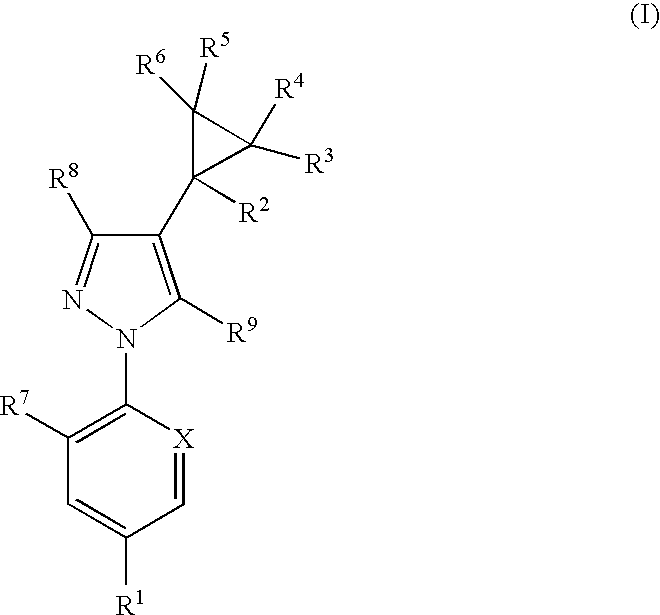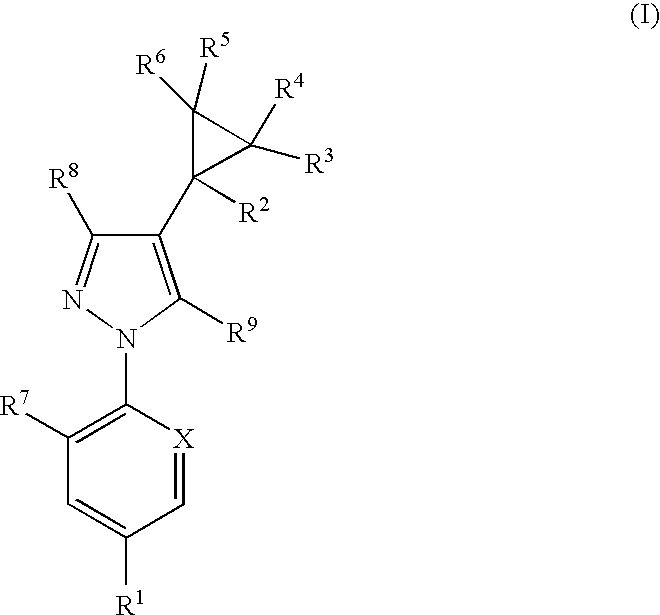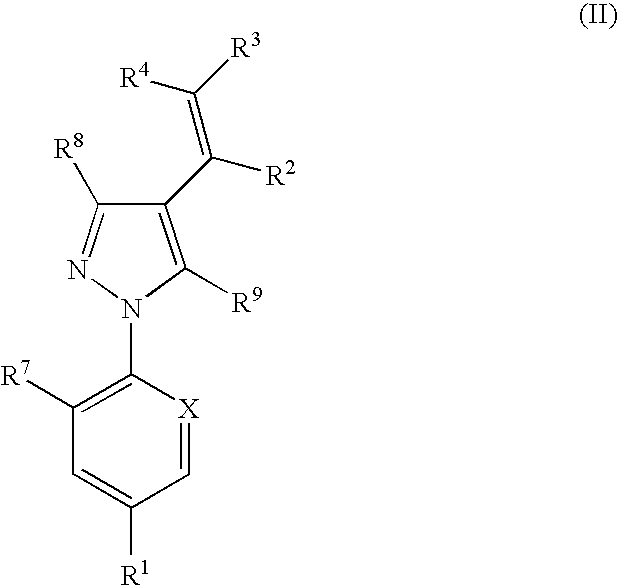Combination
a technology of conjugation and compound, applied in the field of conjugation, can solve the problems of poor activity, poor activity, and inability to demonstrate good activity or a long duration of action against parasites in the prior art compound
- Summary
- Abstract
- Description
- Claims
- Application Information
AI Technical Summary
Benefits of technology
Problems solved by technology
Method used
Image
Examples
example 1
Cyclopropylmethyl {4-[1-(aminocarbonyl)cyclopropyl]-3-cyano-1-[2,6-dichloro-4-pentafluorothiophenyl]-1H-pyrazol-5-yl}carbamate
[0364]
[0365]To the compound of Preparation 1 (310 mg, 0.5 mmol) in tetrahydrofuran / water (4:1, 5.2 ml) was added lithium hydroxide monohydrate (218 mg, 5.2 mmol) and the reaction mixture was stirred at room temperature for 24 h. The reaction mixture was acidified with hydrochloric acid (1 M) and extracted with ethyl acetate. The combined extracts were washed with water, dried (MgSO4) and concentrated in vacuo.
[0366]To a solution of the residue in tetrahydrofuran (5.20 ml), at 0° C., was added triethylamine (185 ml, 1.3 mmol) and ethyl chloroformate (60 ml, 0.6 mmol). After stirring for 30 min, aqueous ammonium hydroxide solution (3 ml) was added and the reaction mixture was warmed to room temperature. The reaction mixture was adjusted to pH 1 by addition of hydrochloric acid (1 M) and extracted with ethyl acetate. The combined extracts were washed with water,...
example 2
1-{5-Amino-3-cyano-1-[2,6-dichloro-4-pentafluorothiophenyl]-1H-pyrazol-4-yl}-cyclopropanecarboxamide
[0370]
[0371]To a solution of the compound of Preparation 10 (615 mg, 1.3 mmol) and triethylamine (204 μl, 1.5 mmol) in tetrahydrofuran (20 ml), at −10° C., was added dropwise ethyl chloroformate (140 μl, 1.5 mmol). The mixture was stirred at 0° C. for 1 h, before addition of ammonium hydroxide (35% in water, 737 μl, 13.3 mmol) in tetrahydrofuran. The reaction mixture was then stirred at 0° C. for 1 h.
[0372]To the reaction mixture was added brine and the mixture was extracted with ethyl acetate. The combined extracts were dried (MgSO4) and concentrated in vacuo to give the crude product.
[0373]The residue was dissolved in acetonitrile (1 ml) and purified by automated preparative liquid chromatography (Gilson system, 150 mm×50 mm Phenomenex LUNA C18(2) 10 μm column) using an acetonitrile:water gradient [45:55 to 95:5]. The appropriate fractions were concentrated in vacuo to give title co...
example 3
1-{3-Cyano-1-[2,6-dichloro-4-pentafluorothiophenyl]-5-[(2-fluoroethyl)amino]-1H-pyrazol-4-yl}cyclopropanecarboxamide
[0377]
[0378]To a solution of the compound of Preparation 11 (150 mg, 0.3 mmol) in tetrahydrofuran (5 ml), at 0° C., was added triethylamine (165 μl, 1.2 mmol), followed by ethyl chloroformate (65 μl, 0.6 mmol). After stirring for 30 min, the mixture was quenched by addition of aqueous ammonium hydroxide solution. The reaction mixture was partitioned between water and ethyl acetate and the two layers were separated. The organic layer was washed with hydrochloric acid (10%) and brine, dried (MgSO4) and concentrated in vacuo. The residue was dissolved in acetonitrile / water (9:1, 2 ml) and purified by automated preparative liquid chromatography (Gilson system, 150 mm×30 mm LUNA C18 10□m column) using an acetonitrile:water gradient [55:45 to 95:5]. The appropriate fractions were combined and concentrated to give the title compound (61 mg).
[0379]Experimental MH+ 508.1; expec...
PUM
| Property | Measurement | Unit |
|---|---|---|
| Composition | aaaaa | aaaaa |
Abstract
Description
Claims
Application Information
 Login to View More
Login to View More - R&D
- Intellectual Property
- Life Sciences
- Materials
- Tech Scout
- Unparalleled Data Quality
- Higher Quality Content
- 60% Fewer Hallucinations
Browse by: Latest US Patents, China's latest patents, Technical Efficacy Thesaurus, Application Domain, Technology Topic, Popular Technical Reports.
© 2025 PatSnap. All rights reserved.Legal|Privacy policy|Modern Slavery Act Transparency Statement|Sitemap|About US| Contact US: help@patsnap.com



